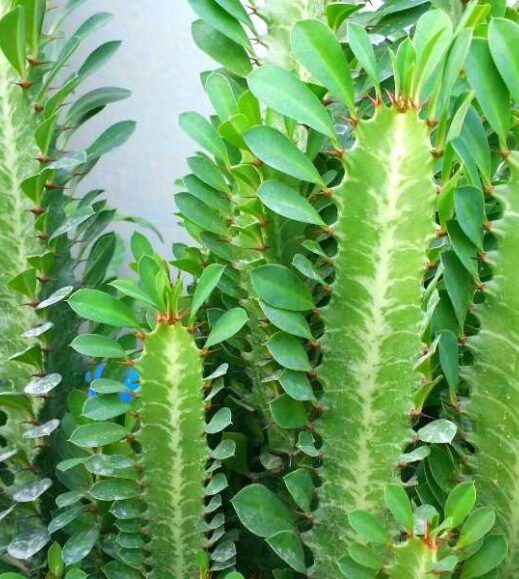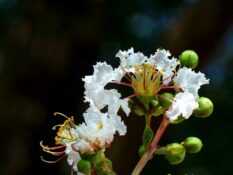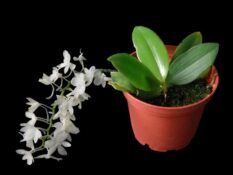Propagate | Soil | Light | Water | Temperature | Humidity | Potting | Pruning | Fertilize | Pest Control | FAQs
The African milk tree plant is a beautiful and unique succulent from Africa's deserts. With its long, blade-like leaves and striking white flowers, this plant makes an eye-catching addition to any garden.
Unlike many other types of succulents, the African milk tree plant does well in hot, dry conditions, making it a great choice for gardeners in climates with low rainfall and high temperatures. In addition to its easy care requirements, this plant is known for its striking and unique appearance, making it a popular choice among avid gardeners and outdoor decorators.
If you are interested in growing an African milk tree plant, this guide will walk you through everything you need to know about caring for this beautiful succulent. From potting and watering requirements to light and temperature needs, we will cover it so you can grow a healthy, thriving African milk tree plant.
Do African milk tree flower? What color is the African milk tree flower?
The African milk tree plant produces beautiful white flowers that bloom from late spring to early summer. These flowers have a long, tube-shaped structure and are typically around 4-5 inches in length. In many cases, the flowers of the African milk tree plant will droop or bend down as they begin to wither, giving this plant it's characteristic "milk" or "tendril" appearance. While some African milk tree plant varieties may produce red or pink flowers instead, most versions of this plant have white blossoms.
When to plant African milk tree plant?
The African milk tree plant can be planted at any time of the year as long as it is in a warm and sunny location. It does best when planted in well-draining soil and will typically start to produce flowers within 1-2 years after being planted.
Types of African milk tree: what are the recommended varieties of African milk tree plants?
There are many different varieties of the African milk tree plant, each with its unique characteristics and growth patterns. Some popular varieties include:
Desert Fire: This African milk tree variety produces bright red flowers and grows around 2-3 feet tall.
Chocolate: This low-growing variety has chocolate-brown leaves and produces white flowers that bloom in late spring or early summer.
White Glow: With its pinkish-white flowers and striking foliage, this African milk tree plant variety is popular among gardeners.
White Bird of Paradise: This variety has striking white flowers and grows around 3-4 feet tall.
Dune Sunburst: This tall variety of the African milk tree plant produces bright yellow flowers and grows around 4-5 feet tall.
As you can see, there are many different African milk tree plants to choose from. Whether you are looking for a low-growing variety or one that produces beautiful flowers, there is sure to be an African milk tree plant that will meet your needs and preferences.
African milk tree soil requirements: What is the best soil for the African milk bush?
The African milk tree plant requires well-draining soil, typically low in nutrients and pH. While the exact soil requirements will depend on the specific variety of this plant you are growing, it is generally recommended to use a nutrient-poor potting mix or cactus mix when planting your African milk tree plant. Additionally, keep the soil slightly dry at all times, as the African milk tree plant cannot tolerate wet soil for long periods.
Make sure to use healthy soil that is free of disease. Adding amendments and enhancers to the soil can help improve plant growth.
African milk tree light requirements: How much light does African milk plant need?
African milk tree plants need plenty of light to grow and thrive. They typically do best when planted in full sun, although some varieties may be able to tolerate partial shade. In most cases, you should avoid planting your African milk tree near large trees or plants that will block out sunlight during the day.
If you're looking to help your plants grow better under low light conditions, using plant grow light designed for specific plant wavelengths can improve growth. You should place these lights several inches above the top of the African milk tree plant and keep them on for at least 8 hours each day. This will promote faster and healthier growth and help your African milk tree plant thrive in even the lowest light conditions.
Watering African milk tree plant: How often should you water an African milk tree plant?
When watering the African milk tree plant, less is more. You should only water your African milk tree plant when the soil becomes completely dry or cracks. This can vary depending on the climate and conditions where you live, so be sure to monitor the soil closely and adjust your watering schedule accordingly.
If you're looking to help your plants grow better under low light conditions, using plant grow light designed for specific plant wavelengths can improve growth.
One of the best ways to keep your African milk tree plant properly hydrated is by using a drip irrigation system or self-watering planter box. These systems help to ensure that your plant gets just the right amount of water without overwatering it or subjecting it to dry conditions.
The frequency of watering depends on the season and the specific environment. To water your plants most effectively, choose an irrigation system that suits their needs.
African milk tree temperature range: What temperature can African milk tree tolerate?
African milk tree plants are fairly tolerant of a wide range of temperatures and can typically thrive in warm climates year-round. In most cases, you should keep your African milk tree plant in an area between 65-85 degrees Fahrenheit. If the temperature drops below this range, you may need extra care to protect your plant from frost or other cold weather conditions.
If you're looking to help your African milk tree plant grow in colder climates, consider planting it in a container so that you can bring it indoors during the winter months. This will ensure that your plant receives plenty of sunlight and stays protected from temperature fluctuations and other environmental stressors.
Be sure to take measures to protect plants during bad weather. You can use a greenhouse, cold frame, and plant protective covers to create a protected environment for your plant that will help keep it healthy and happy year-round.
African milk tree humidity: Do African milk trees like humidity?
In general, African milk tree plants do well with medium humidity levels. They typically prefer an environment with 60-70% relative humidity. In drier climates, you may need to take steps to increase the humidity around your plant, such as by using a humidifier or misting it regularly.
If you're looking to help your African milk tree plant thrive in more humid environments, consider planting it near a fountain or other water feature. This will help increase the moisture levels around your plant and promote faster growth and better flowering.
Several products help to maintain the humidity of plants around your African milk tree, including plant misters, plant pots with built-in reservoirs, and even grow lights that help provide a source of moisture. Just be sure to choose a product that best suits your plants and their needs.
Where to buy African milk tree plant?
If you're looking to buy an African milk tree plant, there are many options available online and in garden centers. Some of the best places to purchase these plants include nurseries, online gardening catalogs, and local plant markets.
Before choosing a specific plant, it's important to research its growing requirements to ensure that it will thrive in your climate and environment. This can help ensure that you select a plant best suited for your needs and that you have all the tools and supplies necessary to keep it healthy and thriving.
African milk tree plants can be found at many nurseries and garden centers. You can also order them online from a variety of online retailers. When looking for planting materials, look for plants that are healthy and free of pests or diseases. Always inspect the roots before purchasing your plant, and avoid any signs of rot or decay. Do your research beforehand to find reputable sellers with high-quality planting materials.
African milk tree plant propagation: How to propagate African milk tree plant?
Propagating plants is the process of creating new plants from existing ones. It's a great way to propagate your favorite varieties or save money by producing new plants for free. There are several different methods of African milk tree plant propagation, including by seeds, cuttings, and division.
Propagate African milk tree plant from seed
African milk tree plants can be propagated from seeds. To do this, you will need to collect the seeds from an existing plant and either sow them directly in the soil or germinate them using a damp paper towel. Once the plants have grown and reached a certain size, you can transplant them into pots or your garden as needed.
Propagating African milk tree plant by cutting
African milk tree plants can also be propagated from cuttings. This involves cutting a small piece of the plant, such as a stem or leaf, and then planting it in the soil to grow into a new plant. Depending on your cutting, it may need to dry out completely or stay moist while rooting.
When choosing which cuttings to use, it's important to consider the different types and how well they will work for your specific plant. For example, softwood cuttings are good for growing new plants from relatively young stems, while hardwood cuttings are better for older stems and can help produce more flowers in the future.
Propagating African milk tree plant by division
African milk tree plants can also be propagated through division. This involves digging up the plant from its original container or soil and dividing it into multiple pieces, replanting it in new containers or directly in the garden.
When dividing your African milk tree plant, it's important to do so carefully and with clean, sharp pruning shears. Keep as many of the plant's roots and stem intact as possible, and ensure that each piece is healthy and free of pests and diseases.
When done properly, these methods of propagating Amazonian elephant's ear plants are quick and effective ways to produce new plants from old ones. Make sure you choose the right time of year, and always start with good quality and healthy planting materials.
Potting African milk tree plant
African milk tree plants are typically grown in pots or planters. These containers should be large enough to provide plenty of space for the plant's roots and allow them to grow freely without being too crowded. To pot your African milk tree plant, start by adding a layer of potting soil to the bottom of your container and then placing the plant on top.
Once your African milk tree plant is in its new container, you can add more potting soil around the base to help secure it and provide enough space for healthy growth. Be sure to water your plant regularly and check for signs of pests or diseases that may affect its health. With some care and attention, your African milk tree plant will thrive in its new pot and produce beautiful flowers for many years.
It is important to select the correct pot size or container for your African milk tree ear plant, as the container's size will significantly impact its growth and overall health. For best results, look for a container with ample drainage holes at the bottom and deep enough to accommodate the full size of your plant's root system.
How to prune African milk tree plant?
Pruning is an essential part of gardening, as it helps to maintain the health and shape of your plants. There are various pruning tools on the market, including pruners, loppers, saws, and pruning shears. This will help you avoid damaging the plant and reduce the risk of disease or pests.
When pruning your African milk tree plant, remember the following tips. First, you should always prune plants during their dormant season, which is late fall or early spring for most African milk tree plants. This will ensure that the wounds caused by pruning don't get infected and can heal properly over winter.
Additionally, it would help if you always pruned in a way that promotes the growth of new branches and leaves. This means removing any branches or shoots that are dead, diseased, or damaged by pests and insects, while also taking care not to remove too many leaves at once. With proper pruning techniques, your African milk tree plant will be healthy and beautiful for many years.
How to fertilize African milk tree plant?
To help ensure the health and growth of your African milk tree plant, it's important to fertilize them regularly. Various fertilizers on the market, including liquid or granular options, can be applied directly to the soil or added to watering cans as needed.
When fertilizing your African milk tree plant, check the soil and identify any deficiencies. This will help you determine which nutrients need to be added and prevent over-fertilization or nutrient toxicity.
Next, mix your fertilizer according to the manufacturer's instructions and apply it evenly across the soil's surface. Water your plant regularly and avoid over-fertilization, as this can lead to nutrient toxicity or imbalances in the soil that can damage your plant's health. You can help your African milk tree plant grow strong and healthy for many years with proper fertilizer applications.
Choose a high-quality fertilizer with a balanced NPK (nitrogen, phosphorus, and potassium) ratio to fertilize your African milk tree. Some of the plants also benefit by adding appropriate soil amendments.
Common African milk tree diseases and how to manage African milk tree disease?
African milk tree plant is prone to a few common pests and diseases, including:
Mildew: This fungal disease can affect the leaves and stems of your African milk tree, causing them to appear wilted or discolored. To prevent mildew from affecting your plant, be sure to provide plenty of space for proper air circulation, avoid over-watering, and keep your plant in a location that receives full sunlight.
Scale insects: These tiny pests can cause damage to the leaves and stems of your African milk tree, making it more susceptible to disease. To prevent scale infestations, regularly inspect your plant for signs of pests and take action immediately if you notice any problems. You can remove these pests by hand or use organic pesticides to eradicate them.
Aphids: These small, sucking insects can cause leaves to turn yellow and drop off, making your plant more susceptible to disease. To prevent aphid infestations, regularly inspect your plant for signs of pests and treat it with organic pesticides if necessary. You can also encourage natural predators like ladybugs in the area to help keep these pests under control.
If your African milk tree becomes infected with a disease, the best action is to immediately remove and dispose of any diseased parts of the plant. You can also try using organic fungicides or other treatments as directed by your local garden center. Regular monitoring and maintenance can help keep your African milk tree healthy and thriving no matter what pests or diseases come its way.
Taking good care of your African milk tree plant is key to keeping it healthy and free from pests and diseases. Make sure you are watering your plant regularly, providing it with plenty of sunlight, and monitoring for signs of stress or damage. Additionally, practice good garden hygiene by removing any diseased leaves or debris, and take advantage of natural pest control methods whenever possible. Use good quality insecticides and fungicides if there is an outbreak of disease or pests. Always follow the instructions carefully to minimize any potential harm to your plants.
Takeaway on how to grow and care for African milk tree
The African milk tree (Euphorbia trigona) is a drought-tolerant, tropical evergreen that can be grown indoors and outdoors. It grows best in full sun to partial shade and in well-draining soil that's consistently moist. To help your African milk tree thrive, provide it with plenty of space for air circulation and use a high-quality fertilizer with balanced NPK levels to keep it healthy. Additionally, regularly inspect your plant for signs of disease or pests and remove any damaged parts as soon as possible. You can help your African milk tree thrive for many years with proper care.
Explore our plant grow and care guides collection if you want to add some more plants to your garden plant grow and care guides collection.
If you're new to gardening or a seasoned pro, join our supportive AgFunnel community of gardeners. Share a picture of your garden and receive support from fellow plant lovers. Happy gardening.

How to master gardening? Download these essential home and gardening ebooks today!
FAQs
What is African milk tree?
African milk tree, known scientifically as Euphorbia trigona, is a tropical evergreen shrub prized for its drought tolerance and ornamental qualities. It grows best in full sun to partial shade and in well-draining soil that's consistently moist. Some of the most common pests and diseases that the African milk tree is prone to include scale insects, aphids, and fungal infections.
Where to put African milk tree?
Today, you can grow African milk trees in various settings, including inside your home or garden. It generally grows best in full sun to partial shade and in well-draining soil that's consistently moist. For the best results, ensure you have plenty of space for air circulation and use a high-quality fertilizer with balanced NPK levels to keep your plant healthy.
How often should African milk tree be watered?
The exact watering frequency will depend on several factors, including the climate in your area, the size and type of plant, and the soil conditions. Generally speaking, you should water your African milk tree regularly to keep it well-hydrated. Always use water free of chlorine or other chemicals to help prevent problems like root rot or other issues.
How to get African milk tree to bloom?
One of the best ways to encourage your African milk tree to bloom is to provide the right conditions for growth. You will need to provide your plant with plenty of sunlight, water, and good-quality fertilizer. Additionally, you may need to regularly prune your African milk tree to maintain its shape and size. However, it's important to note that not all African milk trees will bloom regularly, so it may take a bit of experimentation to find the right conditions for your specific plant.
Does African milk tree plant like sun or shade?
African milk tree prefers full sun to partial shade, although there may be some variation depending on the variety and other factors. To help your African milk tree thrive, ensure you have plenty of space for air circulation and use a high-quality fertilizer with balanced NPK levels to keep your plant healthy. Additionally, regularly inspect your plant for signs of disease or pests and remove any damaged parts as soon as possible.
Is the African milk tree plant annual or perennial?
The specific lifespan of your African milk tree plant will depend on several factors, including the variety and growing conditions. In general, however, most African milk tree plants are considered to be annual or tropical perennials. This means that they may live for 1-3 years or longer, depending on the specific conditions in your area.
Does the African milk tree plant come back every year?
Various African milk trees may bloom and grow throughout the year; however, they are generally considered annual plants. This means they will not typically survive the winter and must be replanted yearly. However, some tropical perennial varieties may live for several, as the African milk tree plant can be a great plant for a "silent night" and a good night's sleep.
Are African milk tree plants toxic to cats?
Yes, African milk tree plants can be toxic to cats, and they may cause various symptoms if your pet eats any part of the African milk tree plant. However, it's important to note that some African milk tree plant varieties may contain toxic compounds that can negatively impact your cat's health. If you suspect your cat has eaten part of an African milk tree, contact a veterinarian immediately for advice on how to proceed.
Are African milk tree plants toxic to dogs?
Yes, African milk tree plants can be toxic to dogs, and they may cause various symptoms if your pet eats any part of the African milk tree plant. However, the specific level of toxicity in different African milk tree varieties may vary, so it is important to take some time to understand the risks.
Are African milk tree plants toxic to pets?
African milk tree plants can be toxic to pets, and they may cause various symptoms if your pet eats any part of the African milk tree plant. However, the specific level of toxicity in different African milk tree varieties may vary, so it is important to take some time to understand the risks.
How cold can African milk tree plants tolerate?
African milk tree plants can generally tolerate a wide range of temperatures, from fairly mild summer to more extreme cold in the winter. However, it's important to note that African milk tree plants may be more sensitive to cold at the beginning of their growing season, so you may need to take extra precautions if you're planting your African milk tree in the fall or winter.
How often to water the African milk tree plant?
The specific needs of your African milk tree plant will depend on several factors, including the growing conditions in your area and the variety you have. In general, however, you should water your African milk tree plant regularly, at least once or twice weekly. Make sure to regularly inspect the soil and make necessary changes to your watering schedule.
When to stop watering the African milk tree plant?
The specific timing of when to stop watering your African milk tree plant will depend on several factors, including the growing conditions in your area and the variety you have. In general, however, you should wait until the soil is dry to the touch before watering again. This will help prevent overwatering and support the health of your African milk tree plant.
Can the Care Guide for African Milk Trees Also Apply to Growing African Mask Plants?
The care guide for African Milk Trees may not directly apply to growing African Mask Plants. However, both plants thrive in similar conditions like well-draining soil, bright indirect light, and occasional watering. When tending to your African Mask Plants, keep in mind the specific needs of the growing Amazonian elephant's ear.
When to fertilize African milk tree plant?
The best time to fertilize your African milk tree plant depends on your area's specific variety and growing conditions. Generally, it's a good idea to fertilize your African milk tree plant in the spring and early summer. Be sure to carefully follow any instructions on the label of your chosen fertilizer, and don't over-apply.












